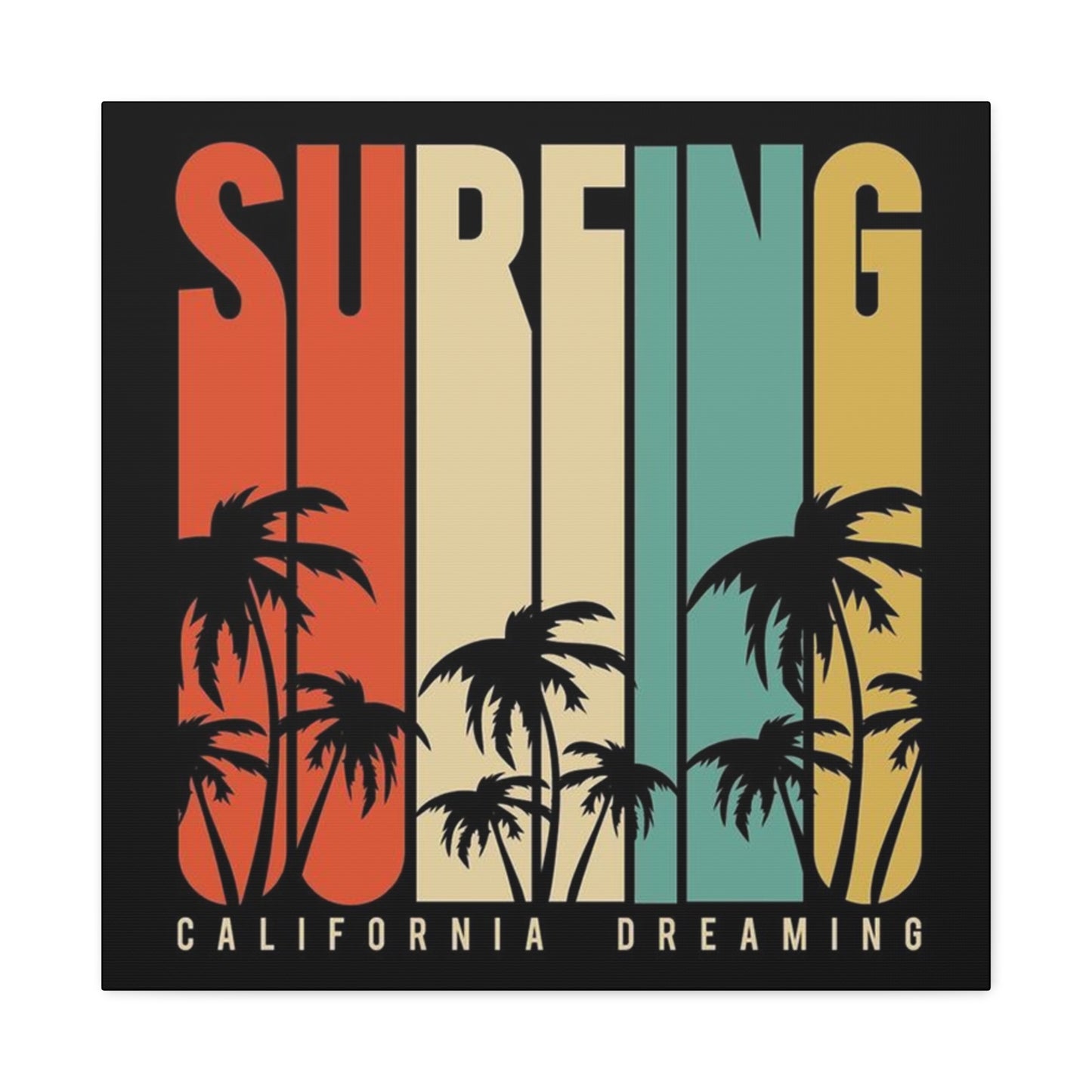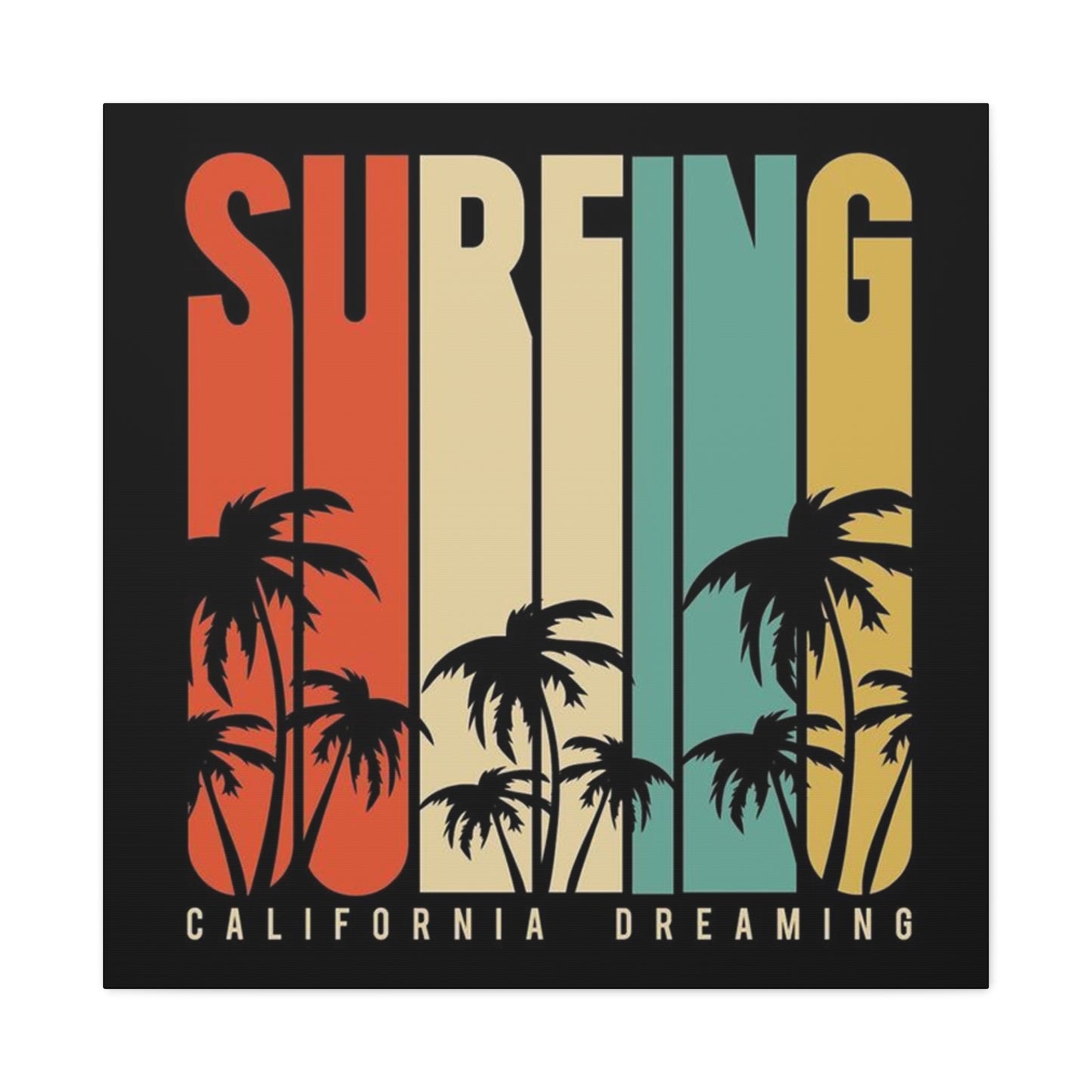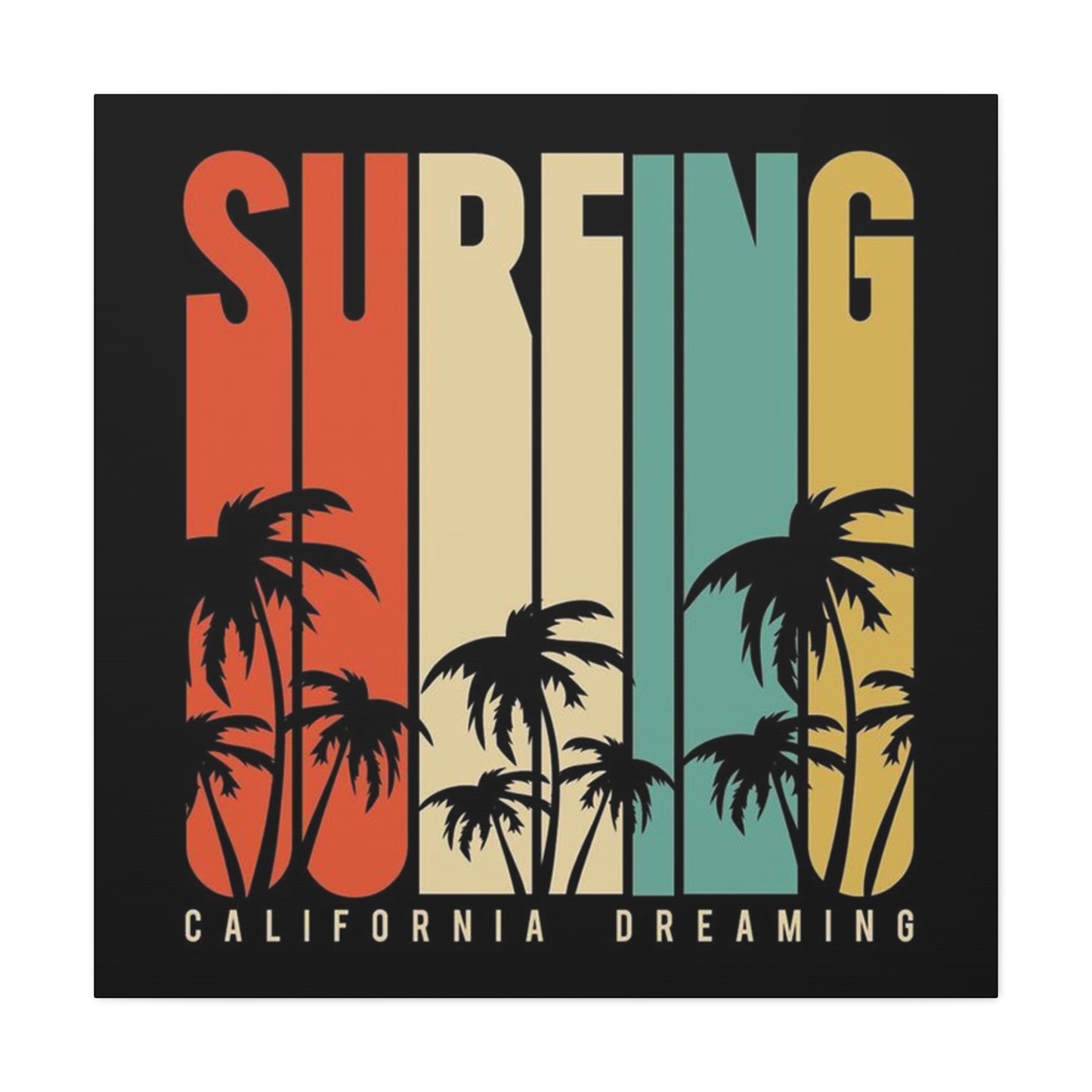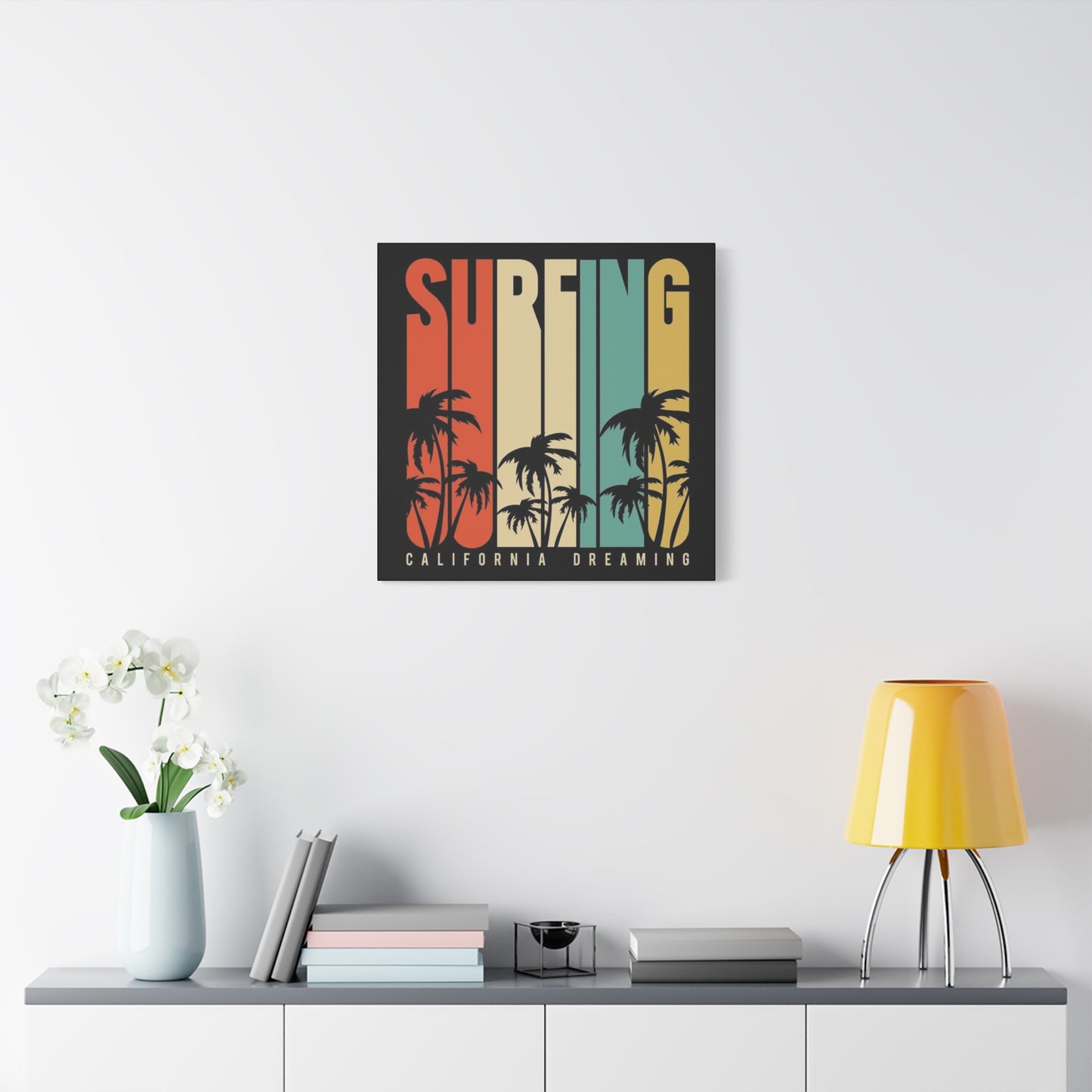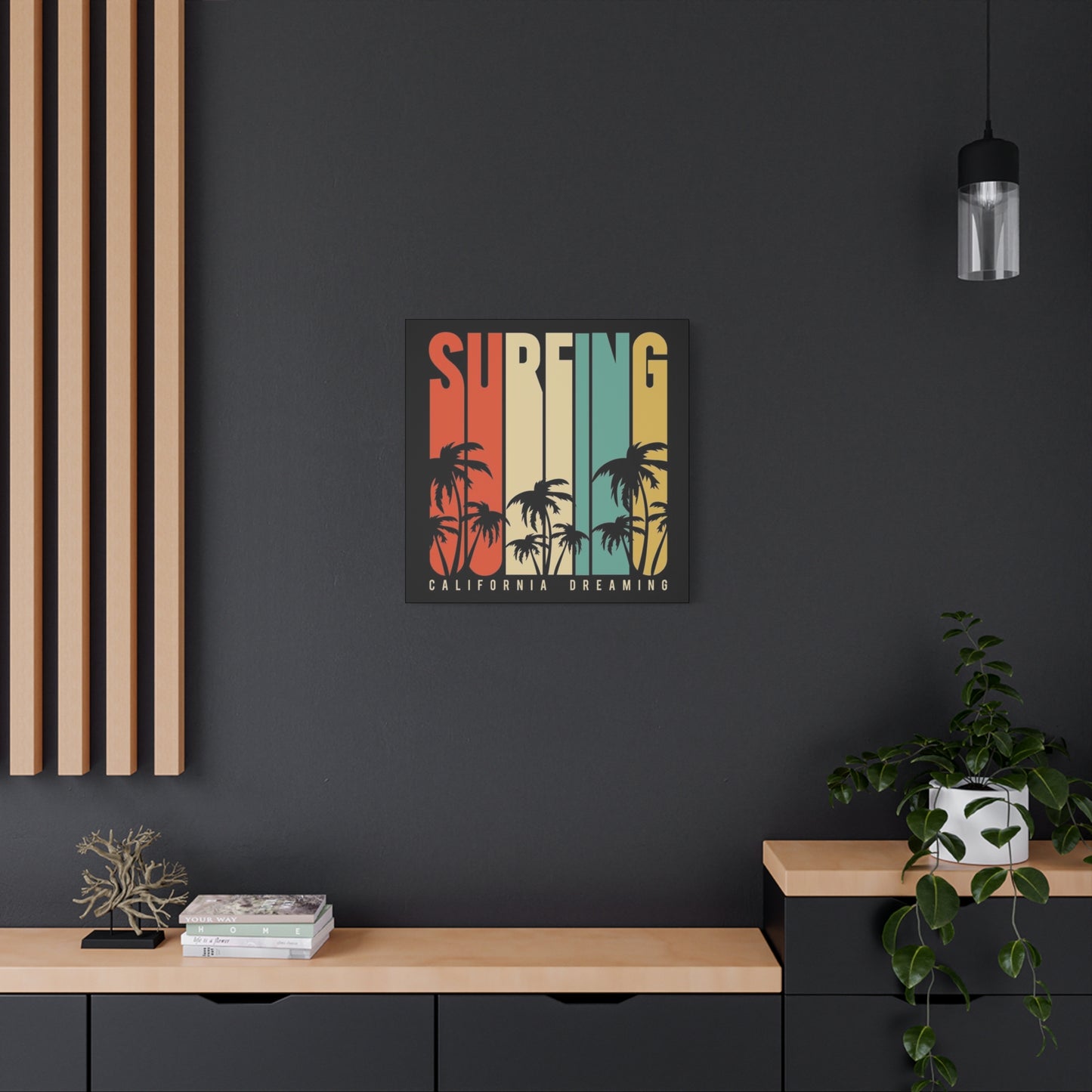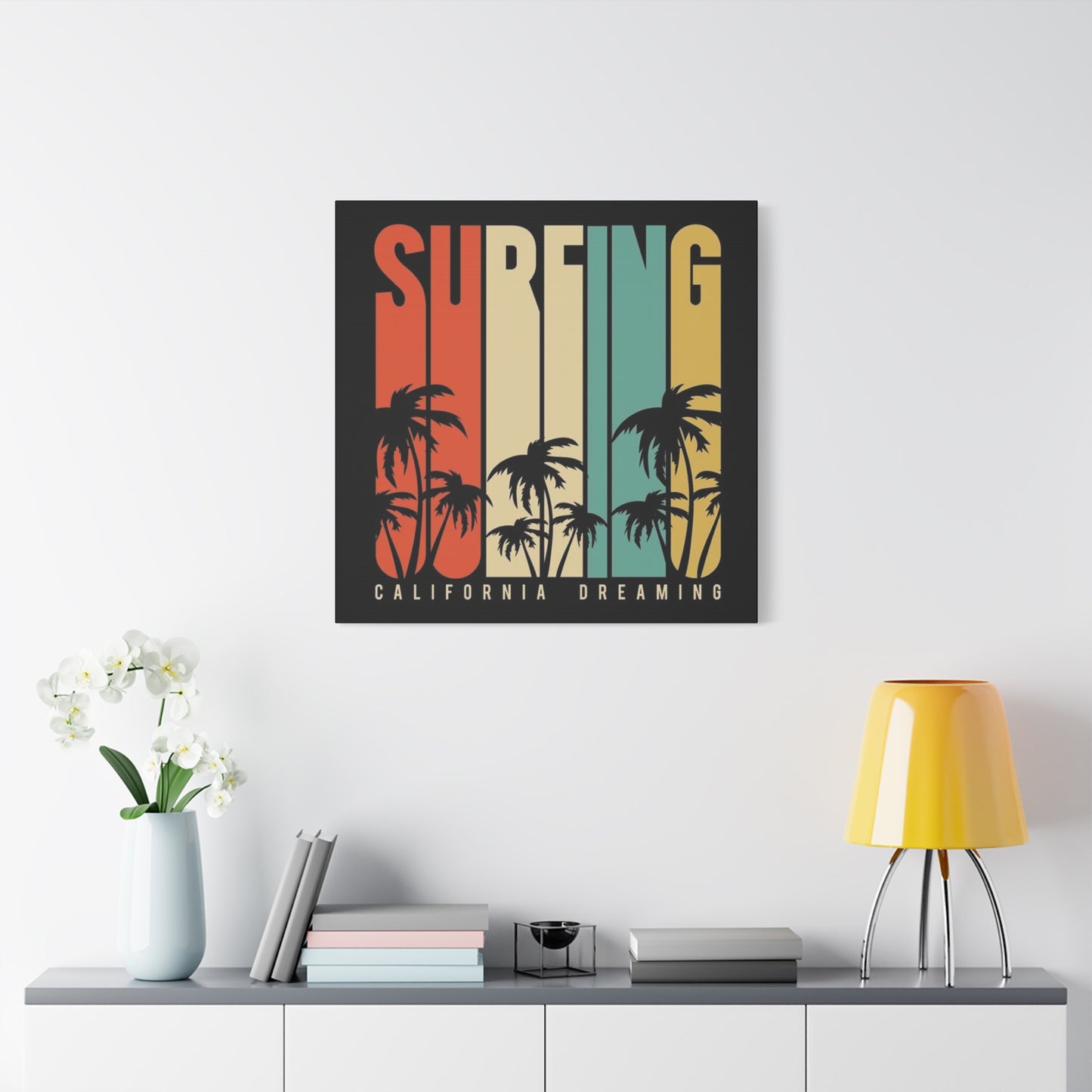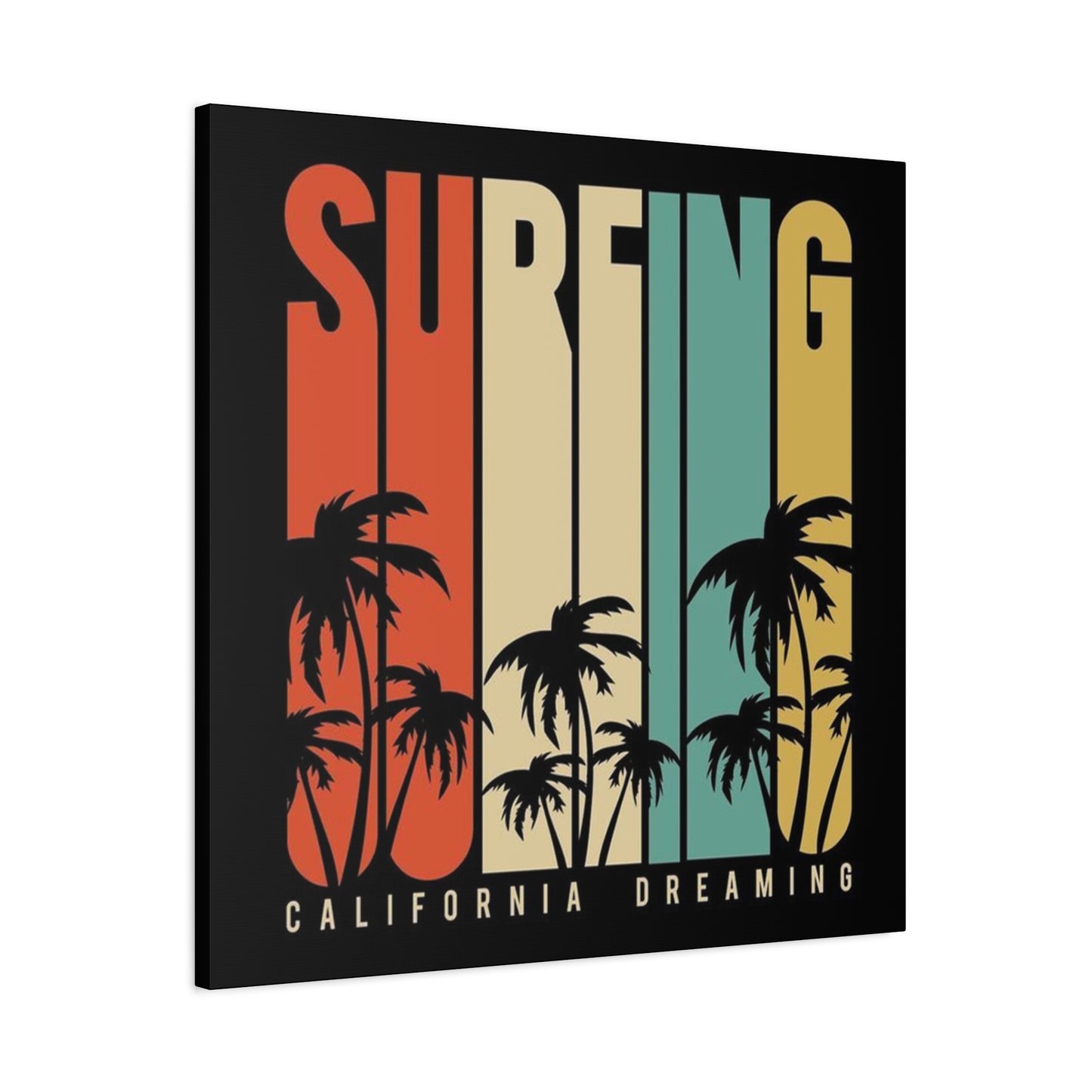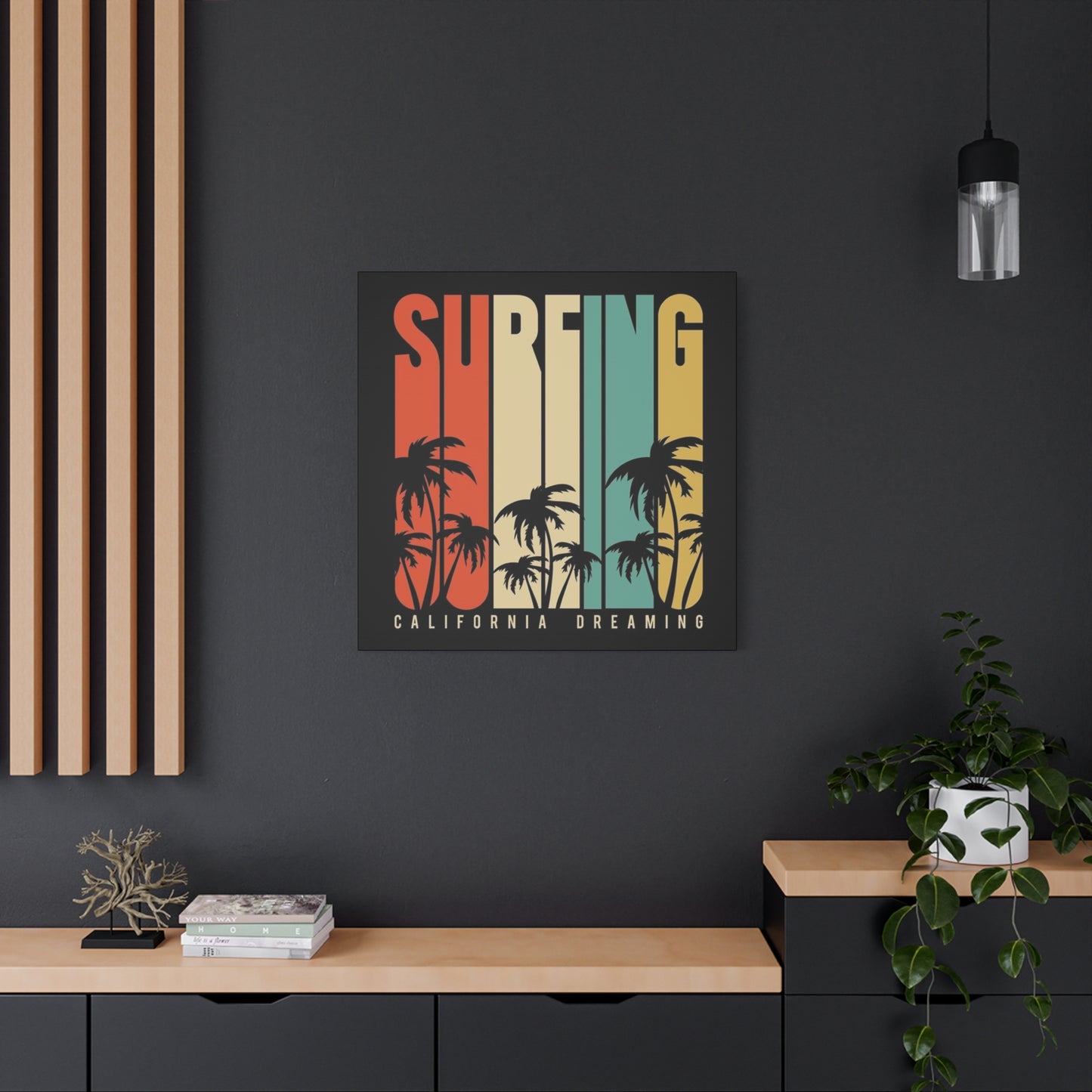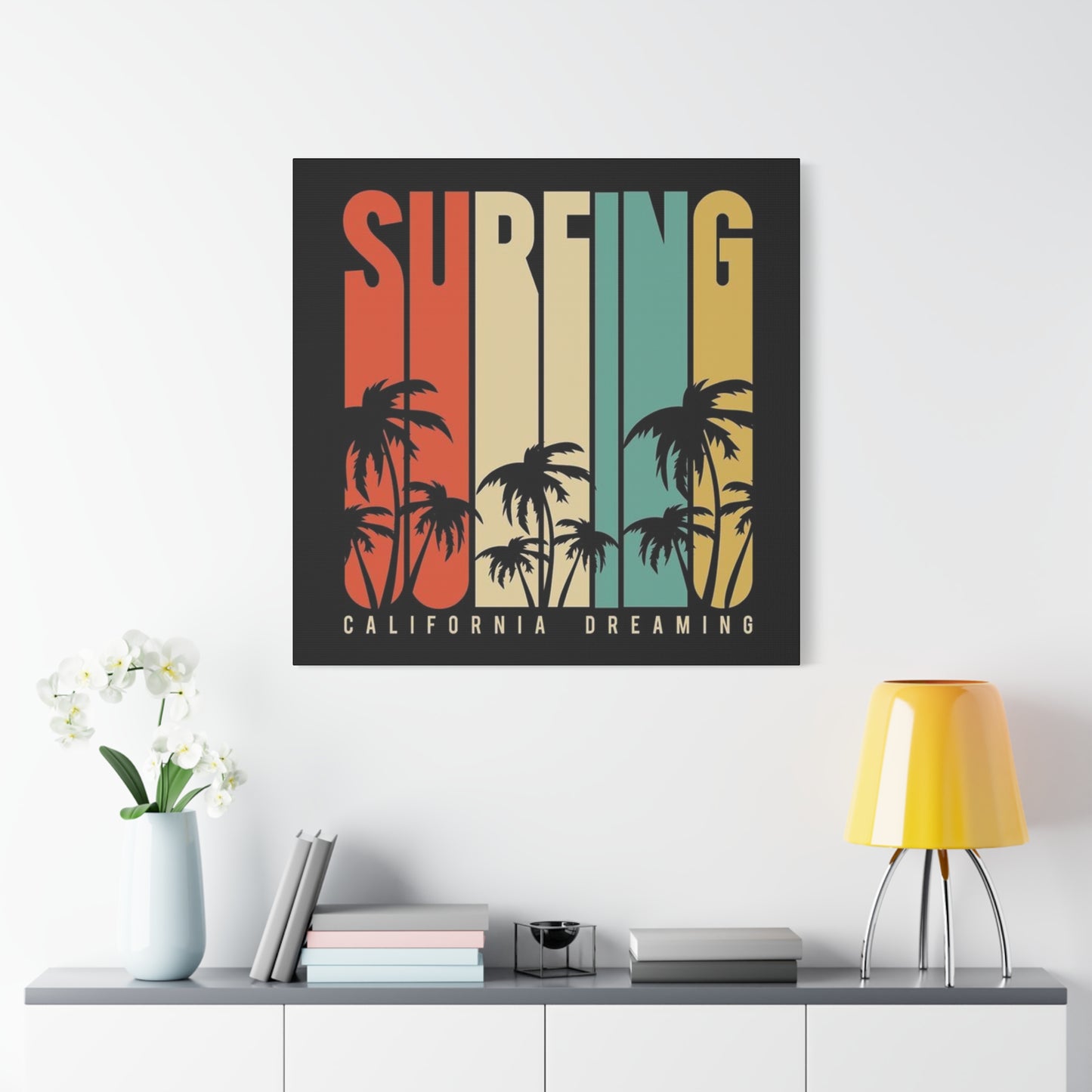Surfing California Dreaming Poster Wall Art: Transform Your Space with Coastal Vibes
The allure of California's coastline has captivated hearts and minds for generations, embodying a lifestyle that celebrates freedom, adventure, and the raw beauty of ocean waves. When you bring this aesthetic into your living space through carefully curated wall art, you're not just decorating; you're creating an atmosphere that speaks to the soul of wanderlust and the timeless appeal of surf culture. Canvas prints featuring surfing scenes and California dreaming themes have become increasingly popular among interior design enthusiasts who want to infuse their homes with the laid-back sophistication that defines West Coast living.
The visual representation of surfing culture through poster art and canvas prints offers more than mere decoration. These pieces serve as windows to an idealized world where the rhythm of waves dictates the pace of life, where golden sunsets paint the sky in breathtaking hues, and where the connection between humans and nature remains unblemished by the complexities of modern existence. Whether you're an avid surfer who lives for the next big wave or someone who simply appreciates the aesthetic beauty of coastal landscapes, incorporating surfing-themed wall art into your interior design scheme can transform any room into a sanctuary of calm and inspiration.
Understanding the Cultural Significance of Surfing Art in Modern Design
Surfing represents far more than a recreational activity or competitive sport; it embodies an entire philosophy of life that has influenced fashion, music, language, and visual arts for decades. The imagery associated with surfing culture carries deep symbolic meaning that resonates with people across different backgrounds and lifestyles. When you choose to display surfing-themed canvas prints in your home or office, you're tapping into a rich cultural heritage that celebrates freedom, courage, connection with nature, and the pursuit of pure joy.
The visual language of surfing art draws from multiple artistic traditions, blending elements of vintage travel posters, mid-century modern design, contemporary photography, and abstract expressionism. This eclectic mix creates a unique aesthetic that feels simultaneously nostalgic and fresh, timeless yet completely relevant to contemporary design sensibilities. The color palettes typically associated with surfing art reflect the natural beauty of coastal environments, featuring deep blues of ocean waters, warm golds and oranges of sunset skies, sandy beiges and tans, and the crisp whites of breaking waves and seafoam.
California's surf culture emerged in the early twentieth century and gained tremendous momentum during the post-war era when beach communities began attracting young people seeking alternative lifestyles. This movement gave birth to a distinctive visual culture that found expression through board designs, poster art, album covers, and eventually the fine art world. Today, surfing imagery continues to evolve while maintaining strong connections to its historical roots, making it a versatile choice for interior design that bridges traditional and contemporary aesthetics.
Exploring Different Styles of Surfing California Dreaming Wall Art
The world of surfing-themed wall art encompasses an impressive variety of styles, each offering unique visual appeal and emotional resonance. Vintage-inspired poster designs capture the golden age of California surf culture with retro typography, simplified color schemes, and nostalgic imagery that evokes feelings of carefree summer days and endless possibility. These pieces often feature stylized representations of surfers riding perfect waves, classic woody wagons loaded with surfboards, or iconic California beach landmarks rendered in the graphic style of mid-century travel advertisements.
Photographic prints represent another popular category within surfing wall art, offering stunning realism that captures the raw power and beauty of ocean waves. Professional surf photographers spend countless hours in challenging conditions to capture that perfect moment when a surfer carves through a massive barrel or when sunlight illuminates a crystal-clear wave face in spectacular fashion. These images translate beautifully to large-format canvas prints, creating focal points that draw viewers into the scene and evoke visceral responses to the majesty of the ocean.
Abstract and contemporary interpretations of surfing themes provide options for those who prefer less literal representations. Artists working in this style might use bold brushstrokes to suggest wave motion, employ color field techniques to evoke the feeling of being surrounded by ocean, or create geometric compositions inspired by the patterns and rhythms of coastal landscapes. These pieces work particularly well in modern and minimalist interiors where they add visual interest without overwhelming other design elements.
Illustrated and hand-drawn styles bring a playful, artistic quality to surfing wall art that appeals to collectors who appreciate the personal touch of original artwork. Whether rendered in watercolors that capture the fluidity of water, pen and ink drawings that emphasize line and form, or digital illustrations that blend traditional and modern techniques, these pieces showcase individual artistic vision while celebrating surfing culture. The handcrafted quality of illustrated surfing art adds warmth and character to spaces, making them feel more personalized and intentional.
Choosing the Perfect Canvas Print for Your Interior Space
Selecting the right surfing-themed canvas print requires careful consideration of multiple factors that will determine how well the piece integrates with your existing decor and serves your design objectives. The size of the artwork plays a crucial role in establishing proper visual balance within a room. Large-scale canvas prints measuring three feet or more in width or height make bold statements and work best as focal points in spacious rooms with high ceilings and ample wall space. These impressive pieces command attention and can anchor an entire design scheme, particularly when positioned above substantial furniture pieces like sofas, beds, or dining tables.
Medium-sized prints ranging from eighteen inches to three feet in any dimension offer versatility and work well in most residential settings. These proportions allow the artwork to have meaningful visual impact without overwhelming the space, making them ideal for standard-sized living rooms, bedrooms, offices, and dining areas. Multiple medium-sized pieces can be arranged in gallery wall configurations to create dynamic visual displays that tell more complex stories about your relationship with surfing culture and coastal living.
Smaller canvas prints under eighteen inches serve important supporting roles in comprehensive design schemes. These compact pieces work beautifully in intimate spaces like bathrooms, hallways, entryways, and home offices where wall space may be limited. They also function effectively as components of larger gallery walls where varying sizes create visual rhythm and prevent monotonous uniformity. When selecting smaller prints, pay particular attention to detail quality and composition to ensure the imagery remains impactful even at reduced dimensions.
Color coordination between your chosen canvas print and existing interior elements significantly influences how harmoniously the artwork integrates into the space. Surfing-themed art typically features ocean blues, sunset oranges and pinks, sandy neutrals, and bright accent colors that reference surfboards, beach umbrellas, and other coastal accessories. Consider pulling one or two dominant colors from your selected artwork and echoing them in throw pillows, area rugs, window treatments, or decorative accessories to create cohesive visual flow throughout the room. This technique helps the artwork feel like an integral part of the design rather than an afterthought.
The Artistic Process Behind High-Quality Canvas Prints
Understanding how premium canvas prints are produced helps you make informed purchasing decisions and appreciate the craftsmanship involved in creating museum-quality wall art. The journey begins with high-resolution digital files or professional photographs that capture extraordinary detail and color accuracy. Whether the source material comes from original artwork that has been professionally scanned or from digital photography files, resolution quality directly impacts the final print's sharpness and clarity. Superior canvas prints start with image files containing millions of pixels, ensuring that even large-format prints maintain crisp details without visible pixelation or blurriness.
The printing process itself employs advanced giclée technology that uses archival-quality inks and sophisticated printing equipment to reproduce colors with remarkable fidelity and depth. Unlike standard printing methods that use four basic colors, professional giclée printing may employ eight, ten, or even twelve different ink colors to achieve subtle gradations and accurate color matching. This expanded color gamut proves particularly important when reproducing the complex hues found in ocean water, sunset skies, and natural landscapes where nuanced color variations create realistic depth and dimension.
Canvas material selection significantly affects both the appearance and longevity of the finished print. Premium cotton canvas provides superior texture and durability compared to synthetic alternatives, offering a substantial feel and professional appearance that elevates the perceived value of the artwork. The canvas weave should be tight enough to prevent ink bleeding while maintaining sufficient texture to create the characteristic look and feel of traditional painted artwork. Properly prepared canvas receives multiple coats of archival-grade gesso that create an optimal printing surface while protecting the fabric from degradation over time.
Stretching and mounting techniques determine how well the canvas maintains its shape and tension throughout its lifespan. Gallery-wrapped canvases extend the printed image around the edges of wooden stretcher bars, creating a polished, frameless presentation that works beautifully in contemporary settings. This method eliminates the need for additional framing while creating a substantial, three-dimensional object that projects from the wall with architectural presence. The stretcher bars themselves should be constructed from kiln-dried wood to prevent warping and should feature corner bracing for added stability, especially on larger pieces.
Incorporating Surfing Art into Various Interior Design Styles
Surfing-themed canvas prints demonstrate remarkable versatility, adapting successfully to numerous interior design styles when selected and displayed thoughtfully. In coastal and beach house interiors, surfing art feels naturally at home, reinforcing the connection between indoor living spaces and the surrounding marine environment. These settings benefit from layering multiple pieces that explore different aspects of surf culture, from action shots of surfers conquering massive waves to serene sunset scenes that capture the peaceful side of beach living. Combining canvas prints with other coastal elements like weathered wood furniture, rope accents, natural fiber textiles, and collections of shells or driftwood creates immersive environments that transport occupants to the seaside.
Modern and contemporary interiors provide excellent backdrops for surfing art that emphasizes clean lines, bold colors, and graphic simplicity. Minimalist spaces with neutral color palettes gain visual interest from carefully selected canvas prints featuring striking compositions and limited color schemes. A single large-scale print can serve as the primary color accent in an otherwise monochromatic room, while smaller pieces might provide subtle visual interest without disrupting the intentional restraint that characterizes modern design. The key lies in selecting artwork that respects the aesthetic principles of the overall design while introducing organic elements that prevent the space from feeling sterile or cold.
Bohemian and eclectic interiors welcome surfing art as part of their diverse visual narratives, mixing and matching different styles, periods, and cultural references with joyful abandon. In these settings, vintage surf posters might hang alongside global textiles, abstract paintings, and personal photographs, creating deeply personal environments that reflect the occupant's varied interests and experiences. The relaxed, adventurous spirit inherent in surfing culture aligns perfectly with bohemian design philosophy, which celebrates individuality, creativity, and freedom from rigid design rules. Layering surfing canvas prints with macramé wall hangings, potted plants, patterned textiles, and collected treasures from travels creates spaces that feel alive with personality and story.
Industrial and urban loft spaces might seem unlikely candidates for surfing art, yet the contrast between rough architectural elements and coastal imagery creates compelling visual tension. Exposed brick walls, concrete floors, and metal fixtures provide dramatic backdrops for vibrant surfing prints that introduce warmth, color, and organic forms into otherwise hard-edged environments. The juxtaposition between the industrial setting and beach imagery serves as visual metaphor for the escape and freedom that ocean activities represent for city dwellers, making these combinations particularly meaningful in urban residential and commercial spaces.
Ocean and Wave Imagery in Interior Spaces
The presence of ocean and surfing imagery in residential and commercial spaces influences occupants' psychological states in measurable ways, contributing to overall wellbeing and quality of life. Research in environmental psychology demonstrates that exposure to nature imagery, particularly water scenes, reduces stress markers, lowers blood pressure, and promotes feelings of calm and restoration. The rhythmic patterns of waves visible in surfing photographs tap into deep-seated human responses to natural rhythms, potentially influencing brainwave patterns toward more relaxed states similar to those achieved through meditation practices.
The color blue, which dominates most surfing and ocean-themed artwork, carries specific psychological associations that benefit interior environments. Blue tones promote feelings of trust, stability, calm, and contemplation, making them ideal for spaces where relaxation and mental clarity are priorities. Bedrooms featuring blue-dominant surfing art may support better sleep quality, while home offices with ocean imagery can reduce work-related anxiety and promote sustained focus. The cooling quality of blue also makes it valuable in spaces that receive abundant natural light or warm afternoon sun, as it creates visual balance against warmer light temperatures.
Surfing imagery specifically carries connotations of adventure, freedom, courage, and mastery that can serve as daily inspiration for occupants facing challenges in their own lives. Viewing photographs of surfers successfully navigating powerful waves reminds us of human potential, resilience, and the rewards that come from confronting fears and pushing beyond comfort zones. For individuals dealing with stress, uncertainty, or the feeling of being overwhelmed by circumstances, surfing art can function as visual affirmation that challenges can be met with skill, determination, and grace.
The horizon line that appears in most surfing and ocean photographs provides an important visual anchor that promotes feelings of stability and perspective. Horizon lines divide compositions into manageable sections while suggesting vast spaces beyond the frame, creating subtle expansiveness that can make interior spaces feel larger and less confining. This quality proves particularly valuable in smaller rooms or spaces with limited natural light, where surfing canvas prints can serve as visual portals that psychologically expand the boundaries of the physical environment.
Considerations for Displaying Canvas Prints Successfully
Proper installation and placement of canvas prints maximizes their visual impact while protecting your investment over time. Understanding the technical aspects of displaying artwork ensures that your surfing-themed pieces look their best and remain in excellent condition for years to come. Lighting considerations rank among the most critical factors affecting how artwork appears in your space. Natural light changes dramatically throughout the day and across seasons, altering the appearance of colors and the visibility of details in your canvas prints. Position artwork to avoid direct sunlight, which can cause fading over time despite protective UV coatings on premium prints. If placement near windows is unavoidable, consider UV-filtering window films or treatments that protect artwork while maintaining natural light flow.
Artificial lighting offers more control over how artwork appears and can be strategically employed to enhance visual impact. Picture lights mounted directly above or below canvas prints provide focused illumination that highlights details and creates dramatic focal points, particularly effective in evening hours when natural light wanes. Track lighting systems offer flexibility in directing light precisely where needed, allowing you to adjust spotlights as you rearrange artwork or modify your interior design. When selecting bulbs for artwork illumination, choose options with high color rendering index ratings that accurately reproduce the full spectrum of colors rather than distorting them with yellow or blue casts.
Hanging height significantly influences how comfortably viewers can engage with artwork and how well pieces integrate with surrounding furniture and architectural features. The general guideline suggests positioning the center of artwork at eye level, typically between fifty-seven and sixty inches from the floor, though this should be adjusted based on ceiling height and viewing circumstances. When hanging canvas prints above furniture pieces, maintain a gap of six to twelve inches between the top of the furniture and the bottom of the artwork to create visual connection without cramping either element. In spaces with particularly high ceilings, consider hanging artwork slightly higher than standard recommendations to prevent it from feeling disconnected from the room's architectural scale.
Gallery wall arrangements require additional planning to achieve balanced, cohesive compositions. Start by arranging pieces on the floor or creating paper templates to experiment with different configurations before committing to wall placement. Maintain consistent spacing between pieces, typically two to four inches, to unify multiple works into a single visual statement rather than a collection of disconnected elements. Mix different sizes and orientations while ensuring the overall arrangement forms a pleasing shape when viewed as a whole. Consider the visual weight of different pieces, placing larger or more colorful prints strategically to anchor the composition and distributing visual interest evenly across the arrangement.
Sustainability Aspects of Canvas Print Production
As environmental consciousness grows among consumers, understanding the sustainability practices behind canvas print production becomes increasingly important for making responsible purchasing decisions. The art printing industry has made significant strides in reducing environmental impact through improved materials, manufacturing processes, and business practices. Eco-conscious consumers can now find surfing-themed canvas prints produced using methods that minimize harm to the environments these artworks celebrate.
Water-based inks have largely replaced solvent-based alternatives in high-quality canvas printing operations, eliminating volatile organic compounds that contribute to air pollution and pose health risks to production workers. These modern ink formulations deliver exceptional color reproduction and longevity while breaking down more safely in natural environments. Some premium canvas printing operations utilize vegetable-based or soy-based inks derived from renewable resources rather than petroleum products, further reducing the carbon footprint associated with each print produced.
Canvas materials themselves vary significantly in terms of environmental impact. Organic cotton canvas represents the most sustainable option, produced without synthetic pesticides or fertilizers that damage soil health and contaminate water sources. Certifications from organizations like the Global Organic Textile Standard provide verification that canvas materials meet rigorous environmental and social criteria throughout the supply chain. Recycled polyester canvas offers another eco-friendly alternative, diverting plastic bottles and industrial polyester waste from landfills and oceans while requiring less energy to produce than virgin synthetic materials.
Wooden stretcher bars and frames can be sourced from responsibly managed forests certified by the Forest Stewardship Council or similar organizations that promote sustainable forestry practices. These certifications ensure that wood products come from forests managed for long-term health and biodiversity rather than destructive clear-cutting operations. Some manufacturers use reclaimed or recycled wood for stretcher bars, giving new life to materials that might otherwise be discarded while reducing demand for newly harvested timber.
Maintaining Canvas Prints for Long-Term Enjoyment
Proper maintenance ensures that your surfing-themed canvas prints retain their visual appeal and structural integrity for decades, protecting your investment while preserving the artwork's ability to enhance your living spaces. Canvas prints require less intensive care than some other art forms, but following basic preservation practices significantly extends their lifespan and appearance quality. Regular dusting prevents accumulation of particles that can become embedded in canvas texture over time, dulling colors and creating a dingy appearance. Use soft, clean microfiber cloths or soft-bristled brushes specifically designed for artwork to gently remove surface dust every few weeks or months depending on environmental conditions.
Humidity control plays a crucial role in canvas preservation, as excessive moisture can cause canvas to sag, stretch, or develop mold and mildew, while extremely dry conditions may cause brittleness and cracking. Maintain relative humidity between forty and sixty percent in spaces where canvas prints hang, using humidifiers or dehumidifiers as needed to achieve stable conditions. Avoid hanging canvas prints in bathrooms, laundry rooms, or other high-humidity areas unless the space features excellent ventilation and humidity control. Similarly, position artwork away from heating vents, fireplaces, and air conditioning units where extreme temperature fluctuations and direct airflow can stress canvas and affect mounting adhesives.
Protecting canvas prints from direct sunlight and UV exposure preserves color vibrancy and prevents fading that occurs when light breaks down pigments in printed inks. While high-quality canvas prints typically feature UV-protective coatings that slow this degradation process, these coatings cannot completely eliminate light damage over extended periods. If displaying prints in sun-filled rooms, rotate their positions periodically or swap pieces between high-light and lower-light locations to distribute exposure evenly. Window treatments that filter UV rays while allowing natural light to enter provide additional protection without requiring complete light blocking that would diminish the room's atmosphere.
Handling canvas prints with clean hands and appropriate care prevents accidental damage that can occur during cleaning, relocation, or storage. Always grip canvas prints by their wooden stretcher frames rather than touching the printed canvas surface, where fingerprints and skin oils can leave permanent marks. When moving or storing canvas prints, avoid stacking them directly against each other, as pressure points can create permanent indentations or transfer residue between pieces. If long-term storage becomes necessary, wrap prints in acid-free paper or breathable fabric before placing them in climate-controlled areas away from potential water sources, pests, and dramatic temperature swings.
The Role of Surfing Art in Commercial and Hospitality Design
Surfing-themed canvas prints extend beyond residential applications into commercial and hospitality environments where they contribute to brand identity, customer experience, and spatial atmosphere. Hotels and resorts in coastal destinations naturally gravitate toward surfing imagery that reinforces their geographic location and appeals to guests seeking authentic beach experiences. These properties often commission or purchase extensive collections of canvas prints that appear throughout public spaces, guest rooms, and amenity areas, creating cohesive design narratives that enhance brand recognition and guest satisfaction.
Restaurants and bars with coastal, California, or surf themes use canvas prints to establish atmospheric authenticity that supports their culinary concepts and target demographics. A beachside seafood restaurant gains credibility and appeal when its interior design thoughtfully incorporates high-quality surfing photography and vintage poster art that demonstrates genuine appreciation for surf culture rather than superficial appropriation. These establishments often rotate artwork seasonally or feature local surf photographers and artists, creating dynamic visual environments that give regular customers reasons to return and providing emerging artists with valuable exposure.
Corporate offices increasingly recognize the value of incorporating nature imagery and lifestyle aesthetics into workplace design to improve employee wellbeing and productivity. Companies based in California or those with brand identities connected to outdoor recreation, wellness, or California lifestyle may feature surfing-themed canvas prints throughout their offices to reinforce corporate culture and values. Break rooms, collaboration spaces, and reception areas benefit particularly from ocean imagery that provides visual respite from work demands and promotes the kind of creative, relaxed mindset that often leads to innovation and problem-solving breakthroughs.
Retail environments selling surf equipment, beachwear, outdoor gear, or California lifestyle products use surfing canvas prints as essential components of their merchandising strategies. These images create aspirational contexts for products, helping customers envision themselves participating in the activities and lifestyle the store represents. Large-format canvas prints serve as dramatic backdrops for product displays, while smaller pieces might accent dressing rooms or checkout areas. The investment in quality wall art signals that a business takes its identity seriously and values aesthetic experience, differentiating it from competitors who neglect visual merchandising.
Customization Options for Personalized Surfing Wall Art
The ability to customize surfing-themed canvas prints allows individuals and businesses to create truly unique pieces that perfectly align with specific design visions, personal memories, or brand requirements. Many canvas printing services accept customer-provided photographs, enabling surfers to display their own best moments on the waves or allowing property owners to feature local surf spots that hold special meaning. This personalization transforms generic wall art into cherished mementos that spark conversations and evoke powerful emotional connections to experiences and places.
Image editing and enhancement services can elevate personal photographs to professional gallery standards, correcting exposure issues, adjusting colors for optimal impact, removing distracting elements, or applying artistic filters that transform standard snapshots into striking visual art. Cropping and composition adjustments help personal photographs work effectively at large scales, focusing attention on the most compelling aspects of the scene while eliminating extraneous details that weaken visual impact. Professional retouching ensures that prints look their absolute best, worthy of prominent display in carefully designed interiors.
Size customization allows canvas prints to fit perfectly into available wall spaces or fulfill specific design requirements. Rather than settling for standard dimensions that might leave awkward gaps or overwhelm a space, custom sizing ensures precise fit and optimal visual balance. Panoramic formats work beautifully for dramatic surf scenes that emphasize the horizontal sweep of coastlines and wave formations, while vertical orientations suit architectural spaces with limited width but substantial height. Square formats offer versatility and modern appeal, working well in both traditional and contemporary settings.
Text additions enable canvas prints to communicate specific messages, commemorate particular events, or reinforce brand identity. Inspirational quotes about surfing, ocean life, or personal growth can be thoughtfully integrated into compositions using typography that complements the imagery and overall design aesthetic. Location names, dates, or coordinates marking significant surf sessions add personal meaning without overwhelming the visual impact of photography or illustration. Businesses might incorporate logos, taglines, or mission statements into custom canvas prints that serve dual purposes as both aesthetic enhancements and brand communications.
Price Points and Value in Canvas Print Markets
The canvas print market spans vast price ranges, from budget-friendly reproductions to investment-quality fine art pieces, making it essential to understand what factors justify different price points and how to assess value when making purchasing decisions. Entry-level canvas prints typically feature lower-resolution printing, thinner canvas materials, basic stretcher bar construction, and minimal quality control processes. While these affordable options may suit temporary decorating needs or spaces where artwork faces higher risk of damage, they generally lack the visual impact and longevity that justify long-term investment.
Mid-range canvas prints represent sweet spots for many consumers, offering significant quality improvements over budget options without reaching premium price territories. These pieces typically feature giclée printing with archival inks, substantial cotton canvas, properly constructed stretcher bars, and quality control measures that ensure consistent results. The visual difference between budget and mid-range canvas prints becomes immediately apparent when comparing them side by side, with mid-range options delivering richer colors, sharper details, and more professional overall presentation. For most residential applications, mid-range prints provide excellent value, delivering museum-quality appearance at accessible prices.
Premium and fine art canvas prints command higher prices due to limited edition status, artist signatures, certificates of authenticity, superior materials, and enhanced production techniques. These pieces often come from renowned photographers or artists whose work has established market value and collectibility. Limited edition prints numbered and signed by artists typically appreciate over time, particularly when the artist's reputation grows or when prints sell out and become unavailable through primary markets. Collectors and serious art enthusiasts willing to invest in premium pieces gain both aesthetic value for their spaces and potential financial return should they eventually sell works from their collections.
Custom canvas prints occupy their own pricing category, with costs varying based on image sources, size specifications, enhancement requirements, and turnaround expectations. Converting personal photographs into gallery-quality canvas prints involves consultation time, image preparation work, test printing, and often multiple proofing iterations to achieve desired results. These additional services justify higher per-piece prices compared to mass-produced standard options but deliver incomparable personal value through customization that creates unique artwork perfectly aligned with individual preferences and memories.
Timeless Classics in Surfing Wall Art
Surfing wall art exists along a spectrum from trend-driven contemporary designs to timeless classics that transcend passing fads, helping buyers make informed decisions about which pieces will deliver lasting satisfaction. Understanding these dynamics prevents impulse purchases that quickly feel dated while identifying enduring designs that maintain appeal across decades. Vintage surf poster aesthetics have demonstrated remarkable longevity, remaining popular for generations while influencing countless contemporary designers who reinterpret classic elements for modern audiences. The bold graphics, simplified color palettes, and nostalgic typography characteristic of mid-century surf posters continue to resonate because they capture essential truths about surfing's appeal that remain constant despite changing times.
Black and white surf photography represents another timeless category that transcends trends through its emphasis on form, light, composition, and the eternal drama of waves and surfers in motion. By removing color from the equation, monochromatic surf images focus attention on fundamental visual elements that define powerful photography. These pieces adapt successfully to virtually any interior color scheme and design style, maintaining relevance regardless of shifting aesthetic preferences. The classic elegance of black and white photography ensures these prints never feel outdated, making them wise choices for long-term display in both residential and commercial settings.
Contemporary trend cycles in surfing art often reflect broader movements in graphic design, illustration, and digital art. Recent years have seen growing popularity of watercolor-style surf prints, geometric abstraction inspired by wave patterns, bold illustration with flat color planes, and digital art that combines photographic elements with graphic overlays. While these styles deliver fresh, current aesthetics that appeal to trend-conscious consumers, their longevity remains uncertain. Buyers drawn to trend-forward designs should consider whether particular pieces will maintain appeal in five or ten years, or whether they serve temporary decorating needs that warrant more frequent refreshment.
Seasonal considerations affect surfing art selection for some consumers who rotate artwork according to time of year or mood preferences. Summer naturally calls for bright, energetic surf scenes featuring vibrant colors and action-packed compositions that celebrate warm weather and beach activities. Winter might inspire preference for more contemplative ocean scenes, dramatic storm surf photography, or monochromatic pieces that acknowledge the season's introspective quality. This approach to seasonal rotation keeps interior spaces feeling fresh and responsive to natural cycles while maximizing the value of art collections through regular redistribution rather than permanent installation of every piece.
The Intersection of Surfing Art and Fine Art Photography
Professional surf photography has evolved from simple documentary recording to recognized fine art discipline, with leading practitioners exhibiting in galleries, publishing monographs, and selling limited edition prints that command substantial prices in the art market. This elevation reflects both technical advancement in photographic equipment and artistic sophistication in how photographers approach their subject. Modern surf photographers combine athletic ability, ocean knowledge, technical mastery, and artistic vision to create images that transcend simple documentation and achieve genuine aesthetic power.
The technical challenges inherent in surf photography contribute to the impressive quality of successful images. Photographers often work in the water alongside surfers, sometimes swimming in dangerous conditions while managing expensive camera equipment in hostile saltwater environments. Capturing critical moments requires anticipating wave and surfer behavior, pre-focusing on exact locations where action will occur, and triggering shutters at precisely the right microsecond to freeze peak action. The physical demands of this work, combined with the unpredictability of ocean conditions, mean that exceptional surf photographs represent hours or even days of effort compressed into single split-second exposures.
Compositional sophistication separates memorable surf photographs from simple snapshots, with leading practitioners demonstrating mastery of fundamental visual principles including rule of thirds, leading lines, balance, negative space, and color harmony. The most compelling surf images use waves, surfers, and surrounding elements to create compositions that guide viewers' eyes through the frame while establishing clear focal points and visual hierarchy. Light quality profoundly affects surf photography's emotional impact, with golden hour side-lighting creating warmth and drama, overcast conditions producing even illumination ideal for color accuracy, and backlit situations generating spectacular silhouettes and highlighting water's translucent qualities.
The art market's embrace of surf photography validates its artistic merit while creating investment opportunities for collectors. Limited edition prints from renowned surf photographers appreciate significantly over time, particularly following sold-out editions or after photographers gain recognition through gallery exhibitions, book publications, or industry awards. Collectors building surf photography collections should research photographers' reputations, edition sizes, print quality, and secondary market performance to make informed acquisition decisions that balance aesthetic appreciation with financial considerations.
Mixing Surfing Art with Other Decorative Elements and Themes
Successfully integrating surfing canvas prints into comprehensive interior design schemes requires thoughtful consideration of how these pieces interact with other decorative elements, art styles, and thematic content. Layering different types of wall art creates visual richness and dimensional interest that single-category displays cannot achieve alone. Surfing prints combine beautifully with other coastal imagery including seascapes, beach still lifes, marine wildlife, and nautical themes that reinforce the connection to ocean environments. This layered approach builds cohesive coastal narratives while providing variety that prevents monotonous repetition.
Contrasting surfing art with completely different themes creates dynamic tension that adds intellectual interest and prevents spaces from feeling one-dimensional or overly themed. A gallery wall might juxtapose surf photography with abstract paintings, vintage botanical prints, or family photographs, revealing the occupant's diverse interests while creating unexpected visual relationships. This eclectic approach works particularly well in personal spaces like homes where authentic representation of individual personality takes precedence over design purity. The key to successful mixing lies in identifying connecting elements like color, composition, or emotional tone that unite disparate pieces despite their different subjects.
Three-dimensional decorative elements extend design themes beyond flat wall surfaces, creating fully realized environments that engage multiple senses. When building spaces around surfing art, consider incorporating actual surfboards as sculptural wall installations, driftwood and rope elements that reference beach environments, vintage surf equipment displayed as historical artifacts, or collections of shells, sea glass, and coral that bring literal pieces of the coast indoors. These dimensional elements activate physical space while reinforcing the lifestyle and values represented in canvas prints, creating immersive environments that transport occupants even when geographic reality places them far from actual coastlines.
Textile selections significantly influence how surfing wall art reads within overall design compositions. Fabrics in solid colors pulled from canvas prints create harmonious relationships that unify spaces, while patterns including stripes, ikat, or geometric designs add energy without competing with photographic imagery. Natural fiber textiles like linen, cotton, jute, and sisal reinforce coastal aesthetics through their organic textures and relaxed drape qualities. Mixing smooth and textured fabrics creates tactile variety that enhances sensory experience, making spaces feel more complete and intentionally considered than those relying solely on visual elements.
Regional Variations in California Surfing Art and Iconic Locations
California's extensive coastline encompasses diverse surf cultures and distinctive landscapes that inspire regionally specific artistic interpretations. Understanding these geographic variations helps collectors and decorators select artwork that resonates with particular locations, memories, or aesthetic preferences. Northern California surf culture centered around areas like Santa Cruz and the Marin coast carries a distinctive character that differs markedly from Southern California's more famous surf scenes. The colder water, frequent fog, rugged coastlines, and powerful waves of the north produce imagery with moodier qualities, often featuring dramatic cliffsides, weathered surfers in full wetsuits, and atmospheric conditions that lend themselves to contemplative, almost melancholic artistic treatments.
Central California's coastline, including areas around Big Sur, San Luis Obispo, and Santa Barbara, offers spectacular natural beauty that inspires awe through sheer visual drama. The region's iconic landmarks like Mavericks, where big wave surfing pushes human limits against some of the world's most dangerous waves, generate powerful imagery that captures both nature's raw power and human courage. Artists working with Central Coast subject matter often emphasize the sublime quality of these landscapes, creating pieces that inspire wonder and respect for natural forces far beyond human control.
Southern California represents surfing's cultural heartland, where beach lifestyle reached its fullest expression and global influence. Iconic locations like Malibu, Huntington Beach, Trestles, and San Onofre appear repeatedly in surfing art because they carry deep cultural significance within surf history. The warm water, consistent waves, and year-round accessibility of Southern California beaches created ideal conditions for surfing's evolution from niche activity to mainstream phenomenon. Art featuring these legendary spots carries nostalgic power for those who learned the sport there while offering aspirational appeal to surfers worldwide who dream of visiting these famous breaks.
The Channel Islands, accessible from Ventura and Santa Barbara, provide pristine surf experiences away from mainland crowds, inspiring artwork that emphasizes isolation, pristine natural beauty, and the adventure of reaching remote breaks. Photography from these locations often captures crystal-clear water, abundant marine life, and empty lineups that represent surfing in its purest form. This imagery appeals particularly to those who view surfing as spiritual practice or wilderness experience rather than competitive sport or social activity, attracting collectors who prioritize contemplative qualities in their wall art selections.
The Evolution of Surf Culture Through Visual Art History
Tracing surfing's visual history through artistic representations reveals fascinating evolution from ancient Hawaiian cultural practice through mid-century American popular culture phenomenon to today's global industry and lifestyle brand. Early depictions of surfing by Western artists who encountered Hawaiian culture in the late eighteenth and early nineteenth centuries approached the subject with exotic fascination, often misunderstanding the deep cultural and spiritual significance surfing held for native Hawaiians. These historical images, while ethnographically problematic, document surfing's roots and provide context for understanding how the practice spread beyond its origins.
The early twentieth century saw surfing's reintroduction to mainland America, primarily through legendary waterman Duke Kahanamoku, whose demonstrations in California and Australia sparked international interest. Visual documentation from this era captures surfing's primitive equipment and techniques while revealing the sport's early adopters as pioneering individualists. Photographs from the 1920s through 1940s show surfers riding heavy wooden boards on gentle waves, providing striking contrast to contemporary images of high-performance surfing on advanced composite boards. These historical images carry significant value for collectors interested in surf culture's roots and evolution.
The 1950s and 1960s represented surfing's golden age in terms of cultural impact and visual style development. This period produced the iconic imagery that still defines surf aesthetics for many people, including woody wagons with surfboards hanging out the back, sun-bleached teenagers in baggy trunks walking toward perfect waves, and vibrant poster art advertising surf films and competitions. The graphic design language developed during this era, with its bold typography, simplified illustrations, and saturated colors, continues to influence contemporary surf art and remains commercially
Conclusion:
Transforming your space with Surfing California Dreaming Poster Wall Art is an effortless way to infuse your surroundings with the laid-back, adventurous spirit of the Golden State. Whether you’re a surfer, a beach enthusiast, or simply someone drawn to the allure of California’s coastal lifestyle, a well-chosen surfing poster can become a focal point in any room. These pieces capture more than just a sport—they encapsulate a lifestyle that embraces freedom, adventure, and the beauty of nature.
The aesthetic appeal of California Dreaming wall art lies in its ability to bring the vivid colors and energy of the coast directly into your home. Surfing posters featuring sunsets, rolling waves, palm trees, and vibrant skies transport you to the California shoreline, where the rhythm of the waves and the soothing atmosphere are always present. Such artwork has the power to evoke nostalgia for those who have experienced the beach culture firsthand and spark a sense of wanderlust in those who dream of one day catching the perfect wave.
The key to a successful home decor transformation lies in the synergy between the room’s existing elements and the poster you choose. The bold, dynamic imagery of surfing art can bring a fresh and exciting vibe to living rooms, bedrooms, or even offices. It's a versatile piece that can be paired with other coastal-themed decor, such as beach-inspired furniture, seashell accents, or light, breezy fabrics. Alternatively, the poster can serve as a statement piece that stands out amidst minimalist surroundings.
Incorporating Surfing California Dreaming Poster Wall Art into your space doesn’t just offer an aesthetic upgrade—it also provides an emotional connection to a place that represents more than just a destination. California is a symbol of possibility, freedom, and the pursuit of a carefree lifestyle. For those who have experienced it firsthand or are drawn to its reputation, this artwork serves as a constant reminder of those ideals. The image of a surfer carving through the waves is not only visually captivating but also represents resilience, balance, and harmony with nature—qualities that resonate deeply in today’s fast-paced world.
In conclusion, whether you’re looking to refresh your home decor or evoke a sense of adventure, Surfing California Dreaming Poster Wall Art is an excellent choice. With its ability to capture the essence of California’s surf culture and its striking aesthetic, it’s more than just a decorative piece. It’s a tribute to the beauty of coastal living, a celebration of adventure, and a visual escape to a place where dreams and the ocean waves meet. Bring the laid-back, sun-soaked vibes of California to your space, and let the spirit of surfing inspire you every day.

















